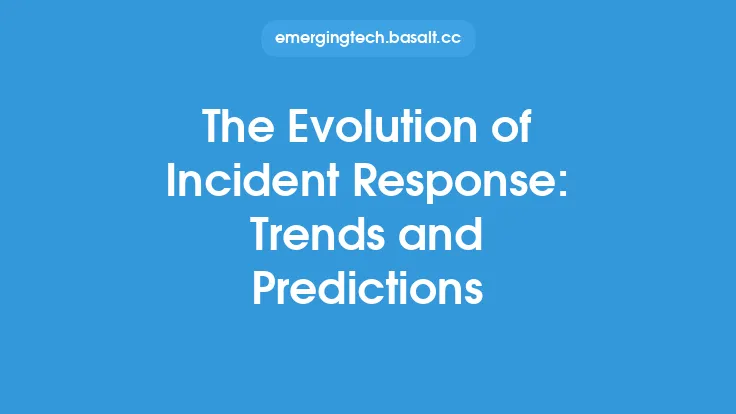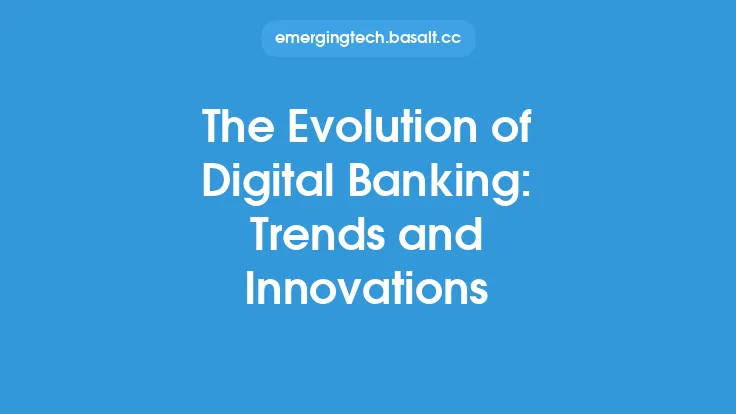The cybersecurity landscape is constantly evolving, with new threats and vulnerabilities emerging every day. As a result, the field of threat intelligence has undergone significant transformations over the years. Threat intelligence refers to the process of gathering, analyzing, and disseminating information about potential or actual threats to an organization's security. In this article, we will delve into the evolution of threat intelligence, exploring the trends and best practices that have shaped the industry.
Introduction to Threat Intelligence Evolution
Threat intelligence has come a long way since its inception. Initially, it was focused on providing basic threat data, such as IP addresses and domain names, to help organizations block malicious traffic. However, as the threat landscape became more complex, threat intelligence evolved to include more advanced capabilities, such as predictive analytics, machine learning, and artificial intelligence. Today, threat intelligence is a critical component of any organization's cybersecurity strategy, providing actionable insights that enable proactive defense against emerging threats.
Trends in Threat Intelligence
Several trends have contributed to the evolution of threat intelligence. One of the most significant trends is the increasing use of automation and machine learning. Automated threat intelligence platforms can analyze vast amounts of data in real-time, identifying patterns and anomalies that may indicate a potential threat. Machine learning algorithms can also be used to predict the likelihood of a threat materializing, enabling organizations to take proactive measures to prevent attacks. Another trend is the growing importance of cloud-based threat intelligence. As more organizations move their infrastructure to the cloud, cloud-based threat intelligence platforms have become essential for providing real-time visibility into cloud-based threats.
Best Practices for Threat Intelligence
To get the most out of threat intelligence, organizations should follow several best practices. First, they should define clear goals and objectives for their threat intelligence program. This includes identifying the types of threats they want to detect, the sources of threat data they will use, and the metrics they will use to measure success. Second, they should implement a threat intelligence platform that can aggregate and analyze threat data from multiple sources. This platform should be able to provide real-time alerts and notifications, as well as predictive analytics and machine learning capabilities. Third, they should establish a team of skilled analysts who can interpret threat intelligence data and provide actionable recommendations to stakeholders.
Technical Aspects of Threat Intelligence
From a technical perspective, threat intelligence involves the collection and analysis of various types of data, including network traffic, system logs, and threat feeds. Threat feeds are particularly important, as they provide real-time information about emerging threats. There are several types of threat feeds, including open-source feeds, commercial feeds, and proprietary feeds. Open-source feeds are freely available and provide basic threat data, while commercial feeds offer more advanced capabilities, such as predictive analytics and machine learning. Proprietary feeds are customized to meet the specific needs of an organization and often provide the most accurate and relevant threat data.
Threat Intelligence and Incident Response
Threat intelligence plays a critical role in incident response, enabling organizations to respond quickly and effectively to security incidents. By providing real-time visibility into emerging threats, threat intelligence platforms can help organizations detect and contain threats before they cause significant damage. Additionally, threat intelligence can help organizations prioritize their incident response efforts, focusing on the most critical threats and vulnerabilities. To integrate threat intelligence into their incident response processes, organizations should establish clear communication channels between their threat intelligence and incident response teams. They should also implement automated workflows that enable rapid response to security incidents.
The Future of Threat Intelligence
As the threat landscape continues to evolve, threat intelligence will play an increasingly important role in helping organizations stay ahead of emerging threats. One of the most significant trends that will shape the future of threat intelligence is the growing use of artificial intelligence and machine learning. These technologies will enable threat intelligence platforms to provide more accurate and predictive threat data, enabling organizations to take proactive measures to prevent attacks. Another trend is the increasing importance of cloud-based threat intelligence, as more organizations move their infrastructure to the cloud. To stay ahead of the curve, organizations should invest in threat intelligence platforms that can provide real-time visibility into cloud-based threats and enable automated response to security incidents.
Conclusion
In conclusion, the evolution of threat intelligence has been shaped by several trends and best practices. By leveraging automation, machine learning, and cloud-based threat intelligence, organizations can gain real-time visibility into emerging threats and take proactive measures to prevent attacks. To get the most out of threat intelligence, organizations should define clear goals and objectives, implement a threat intelligence platform, and establish a team of skilled analysts. As the threat landscape continues to evolve, threat intelligence will play an increasingly important role in helping organizations stay ahead of emerging threats. By investing in threat intelligence and following best practices, organizations can improve their cybersecurity posture and reduce the risk of security incidents.





